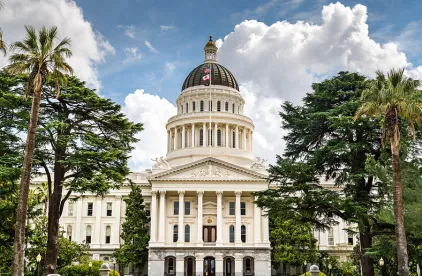On August 31, 2022—the last day of the 2022 legislative session—California legislators passed a package of climate bills aimed at reducing statewide emissions, stimulating the carbon capture industry, and implementing buffers between communities and oil and gas developments. The bills include $54 billion in climate-related spending and come on the heels of other state and federal efforts to reduce carbon emissions across many sectors of the economy.
The package contains the following bills:
-
AB 1279, which codifies California’s existing goal of carbon neutrality by 2045.
-
AB 1757, which requires the state Natural Resources Agency to establish targets for natural carbon sequestration and nature-based climate solutions.
-
SB 846, which authorizes the Diablo Canyon nuclear power plant to continue operations until December 31, 2030, and provides Pacific Gas & Electric Company (“PG&E,” the plant’s operator) with a $1.4 billion loan to help facilitate those operations. While Diablo Canyon was originally going to be retired by 2025, many saw Diablo Canyon’s 2,256 MW as critical for providing carbon-free power during the afternoon and evening ramp.
-
SB 905, which directs the California Air Resources Board (“CARB”) to establish a program to evaluate the efficacy, safety, and viability of carbon capture, utilization, or storage (“CCUS”) and carbon removal technologies. The bill also requires CARB to adopt various regulations governing CCUS and carbon removal projects, including a unified permit application for such projects and measures to minimize leakage from carbon storage reservoirs.
-
SB 1020, which sets interim targets regarding retail sales of electricity. Current law requires 100 percent of all energy sales to California end-use customers to be supplied by eligible renewable energy sources or zero-carbon resources by 2045. SB 1020 sets interim targets of 90 percent by 2035 and 95 percent by 2040. SB 1020 also requires state agencies to source 100 percent of their energy from eligible renewable or zero-carbon resources by 2035—ten years earlier than the current target.
-
SB 1137, which establishes 3,200-foot buffer zones between oil and gas facilities or wells with a wellhead and facilities that qualify as “sensitive receptors,” including private homes, schools, community centers, nursing homes, hospitals, and prisons.
Legislators failed to pass AB 2133, which would have made stricter California’s emissions reduction goals (raising from 40 percent to 55 percent the reduction below the state’s 1990 emissions levels that California would have to meet by 2030).
Each bill now goes to Governor Gavin Newsom to sign by September 30, 2022, which he is expected to do after publicly advocating for them earlier in August. The California legislature’s actions come several days after CARB announced a new rule that would require by 2035 all new cars, trucks, and SUVs sold in the state to be greenhouse gas emission-free. These state-level efforts complement recent federal efforts to catalyze and develop a low-emissions energy economy, notably the Infrastructure Investment and Jobs Act of 2021 (“IIJA,” or Bipartisan Infrastructure Law, which included $47.2 billion for improving climate resilience) and the Inflation Reduction Act of 2022 (“IRA,” which included $369 billion in climate-related spending, tax credits, and incentives). These initiatives represent a concerted effort on both the federal and state level to rapidly shift the economy towards low-emissions energy sources, and consequently provide ample opportunities for new investment opportunities, financing structures, and stakeholders.



 />i
/>i

